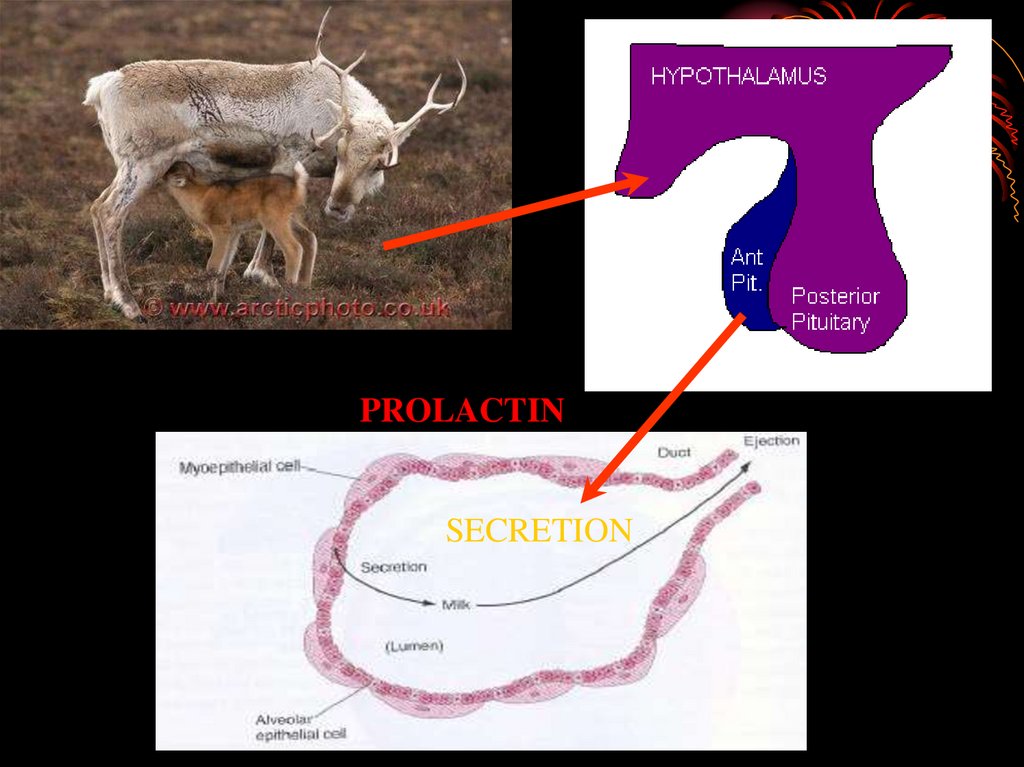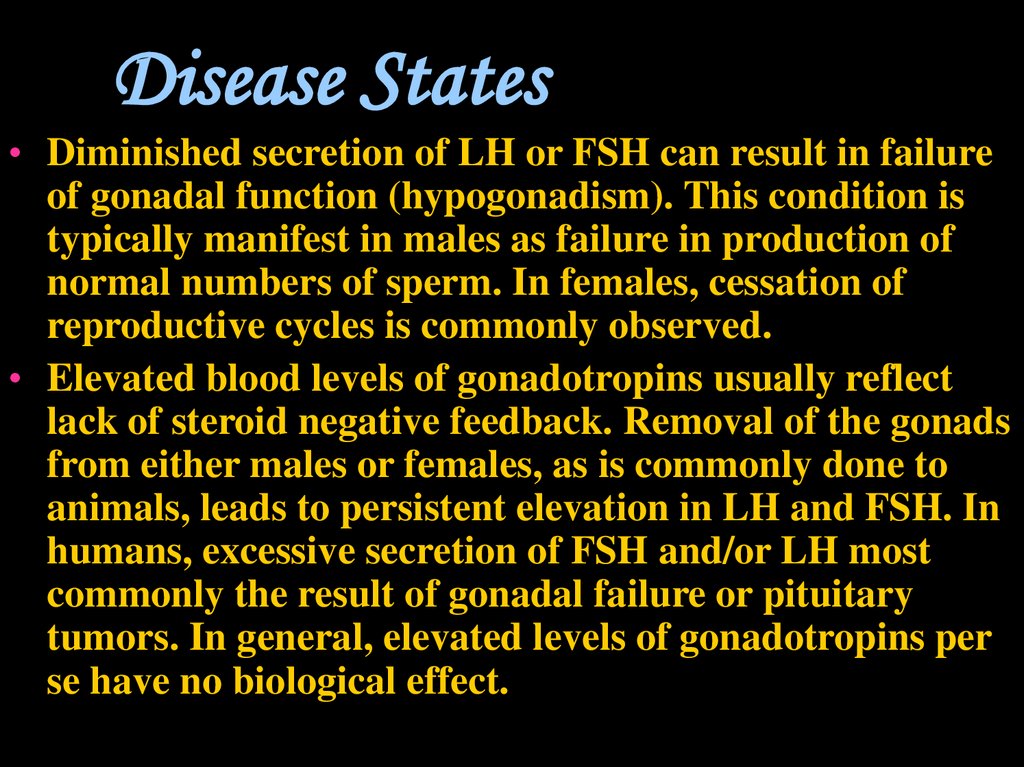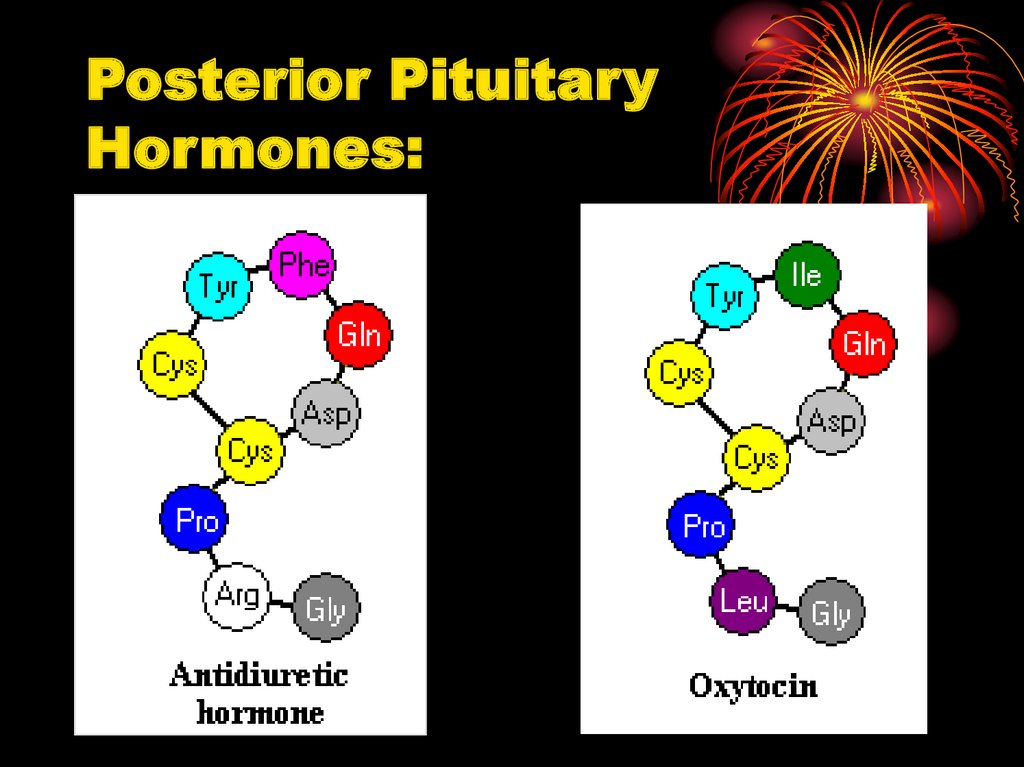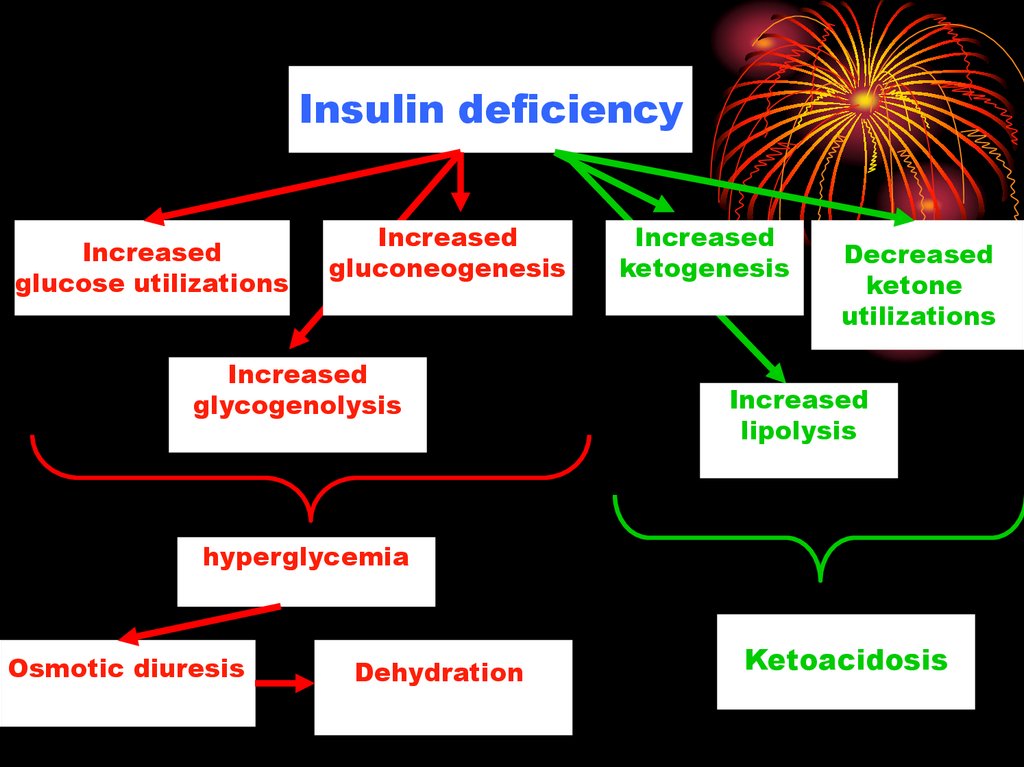Похожие презентации:
Signaling by the neuroendocrine system
1.
2. Signaling by the neuroendocrine system
• Thecoordination
of the body’s
diverse
metabolic
activities is
achieved by
hormonal and
neuronal
signaling
3.
• Hormone: A chemical substancesynthesized in small amounts by
an endocrine tissue and carried in
the blood to another tissue, where
it acts as a messenger to regulate
the function of the target tissue or
organ.
4. Chemical signalling - endocrine, paracrine, autocrine and intracrine mechanisms
intracrineautocrine
paracrine
endocrine
neuroendocrine
5. Function of hormones
HOMEOSTASIS
Reproduction
Growth and development
Maintenance of internal environment
Production, utilization and storage
of energy
6.
• At a minimum, ahormonally regulated
system must include a
secretary gland, a
receptor for the hormone
on or within the target
cell, and some feedback
mechanism (complex
feedback loops) that
regulates the secretion
of the hormone in
response to the function
being regulated.
7.
Hormones function in acomplex hierarchy.
• Hormone act in hierarchy
of function. The hypothalamus functions at the top
of hierarchy of many
hormone-producing
tissues and is the
coordination center of the
endocrine system. It
receives neural input from
diverse regions of the
brain and feedback signals
from hormones circulating
in the blood.
8. CLASSIFICATION OF HORMONES
9.
CLASSIFICATIONOF HORMONES
ACCORDING TO
ANATOMICAL
SOURCE OF
THE HORMONE:
10. CLASSIFICATION OF HORMONES ACCORDING TO CHEMICAL COMPOSITION:
• The peptide hormones, which may have from 3to over 200 amino acid residues, include all of
the hormones of the hypothalamus and pituitary
and the pancreatic hormones insulin, glucagon,
and somatostatin.
• The amine hormones, low molecular weight
compounds derived from the amino acid
tyrosine, include water-soluble epinephrine and
norepinephrine of the adrenal medulla and the
less water-soluble thyroid hormones.
11.
• The steroid hormones, which are fat-soluble,include the adrenal cortical hormones, hormone
forms of vitamin D, and the androgens and estrogens
(the male and female sex hormones). They move
through the bloodstream bound to specific carrier
proteins.
• Eicosanoids are derivatives of the 20-carbon
polyunsaturated fatty acid arachidonate. All three
subclasses of eicosanoids (prostaglandins,
leukotrienes, and thromboxanes) are unstable and
insoluble in water; these signaling molecules
generally do not move far from the tissue that
produced them, and they act primarily on cells very
near their point of release.
12. CLASSIFICATION OF HORMONES ACCORDING TO CHEMICAL COMPOSITION:
Prostaglandin E1(an eicosanoid)
13. Protein/Peptide Hormones
Hydrophilic
Large
Can't fit through membrane
Second messenger mechanism
of action
• Most hormones
• Example: Insulin
14. Steroid Hormones
Small
Hydrophobic/Lipophilic
Travel in blood w/carrier
Cytoplasmic or nuclear
receptors
• change protein synthesis
• Example: estradiol
15.
PEPTIDEHORMONES
16. Why is the Hypothalamus so Important?
STIMULUSHypothalamus
Releasing Hormone
(Release-Inhibiting Hormone)
Pituitary
Stimulating Hormone
Gland
Hormone
Target
17. Hypothalamic hormones:
Liberins or releasinghormones:
1. Corticotropin releasing factor
2. Thyrotropin releasing
hormone
3. Gonadotropin releasing
factor
4. Growth hormone releasings
factor
5. Prolactin-reliasing factor
6. Melanotropin releasing factor
Statines or inhibiting
hormones
1. Somatostatin
2. Prolactostatin
18. Hypothalamic hormones.
Hypothalamic releasing andinhibiting hormones are
carried directly to the
anterior pituitary gland via
hypothalamic-hypophyseal
portal veins. Specific
hypothalamic hormones
bind to receptors on specific
anterior pituitary cells,
modulating the release of
the hormone they produce.
19.
Pituitaryhormones.
20. THE PITUITARY GLAND
The pituitary gland iscomposed of distinctive
parts:
• The anterior pituitary
• The intermediate lobe
• The posterior pituitary
(neurohypophysis)
21.
• Anterior Pituitary Hormones and TheirHormones
1. Growth Hormone
2.Thyroid Stimulating Hormone
3.Adrenocorticotropic Hormone
4.Prolactin
5.Gonadotropins: Luteinizing Hormone and
Follicle Stimulating Hormone
• Intermediate lobe (pars intermedia)
1.MSH (melanocyte stimulating
hormone)
• Posterior Pituitary Hormones
• 1.Antidiuretic Hormone (Vasopressin)
• 2.Oxytocin
22.
TARGETORGAN
OF PITUITARY
HORMONE.
23. 1.
GrowthHormone (GH)
24. Growth Hormone (GH)
• Human growth hormone(somatotropin) is a
protein of 191 amino
acids. The GH-secreting
cells are stimulated to
synthesize and release
GH by the intermittent
arrival of growth
hormone releasing
hormone (GHRH) from
the hypothalamus.
25. Growth Hormone (GH)
GrowthHormone
Liver
IGF-1
Direct
effect
Indirect
effect
GH promotes body
growth by:
• binding to receptors on
the surface of liver cells
• this stimulates them to
release insulin-like
growth factor-1 (IGF-1;
also known as
somatomedin)
• IGF-1 acts directly on the
ends of the long bones
promoting their growth
26. Growth Hormone (GH)
• It promotes protein building in all cells(increase the transport of amino acids
into muscle cells and increases protein
synthesis)
• reduces use of carbohydrate
(antagonist of insulin)
• increases use of fatty acids for energy
(release of free fatty acids and glycerol
from adipose tissue can increase
ketogeneses if diabetes)
• GH influences on nitrogen, and
mineral metabolism.
27. A lack of GH causes dwarfism.
• A deficiency state canresult not only from a
deficiency in production
of the hormone, but in the
target cell's response to
the hormone.
• •Clinically, deficiency in
growth hormone or
receptor defects are as
growth retardation or
dwarfism.
28. An excess results in gigantism or acromegaly.
Gigantism, excess heightand weight. Gigantism
with normal body
proportions and normal
sexual development
usually comes from excess
GH in early childhood.
Gigantism is usually
treated with radiation, but
gland surgery may also be
used.
29. An excess results in gigantism or acromegaly.
Acromegaly , also calledacromegalia. A long-term
problem in which bones of
the face, jaw, arms, and legs
get larger. It occurs in
middle-aged patients. It is
caused by too much growth
hormone. It is treated by xrays to shrink the pituitary,
or part of the pituitary
gland is removed
30. 2.
Thyroid-StimulatingHormone
(Thyrotropin )
31. Thyroid-Stimulating Hormone (Thyrotropin )
Thyroid-stimulatinghormone, also known as
thyrotropin, is secreted
from cells in the anterior
pituitary called
thyrotrophs, finds its
receptors on epithelial
cells in the thyroid gland,
and stimulates that gland
to synthesize and release
thyroid hormones.
32. Thyroid Stimulating Hormone (TSH)
• TSH is a glycoproteinconsisting of:
• a beta chain of 112 amino
acids and
• an alpha chain of 89 amino
acids.
The alpha chain is identical
to that found in two other
pituitary hormones, FSH
and LH as well as in the
hormone chorionic
gonadotropin. Thus, its
beta chain gives TSH its
unique properties.
33. Regulation of secretion of thyroid-releasing hormone.
Regulation of secretion of thyroidreleasing hormone.34.
• Some people develop antibodies againsttheir own TSH receptors. When these bind
the receptors, they "fool" the cell into
making more T4 causing hyperthyroidism.
The condition called thyrotoxicosis or
Graves' disease.
• The deficiencies of TSH causes
hypothyroidism: inadequate levels of T4
and T3.
35. 3.
AdrenocorticotropicHormone
(ACTH)
36. Adrenocorticotropic Hormone (ACTH)
• Adrenocorticotropic hormone issingle-chain polypeptide consisting
of 39 amino acids, as its name
implies, stimulates the adrenal
cortex. More specifically, it
stimulates secretion of
glucocorticoids such as cortisol, and
has little control over secretion of
aldosterone, the other major steroid
hormone from the adrenal cortex by
enhancing the conversion of
cholesterol to pregnenolone.
Another name for ACTH is
corticotropin.
37. Adrenocorticotropic hormone
38. Adrenocorticotropic hormone
39. 4.
PROLACTIN40. Prolactin
• Prolactin – protein of 197 aminoacids.
• Prolactin, acting with other
hormones, starts the growth of the
mammary glands. After childbirth, it
helps to start and maintain the
making of breast milk. This occurs
in response to suckling by the infant.
When suckling stops, prolactin slows
and the breasts stop making milk.
41. Prolactin has two major roles in milk production:
• Prolactin induceslobuloalveolar growth of the
mammary gland. Alveoli are
the clusters of cells in the
mammary gland that
actually secrete milk.
• Prolactin stimulates
lactogenesis or milk
production after giving
birth. Prolactin, along with
cortisol and insulin, act
together to stimulate
transcription of the genes
that encode milk proteins.
42.
PROLACTINSECRETION
43. Disease States
• Excessive secretion of prolactin hyperprolactinemia - is a relative common disorderin humans. This condition has numerous causes,
including prolactin-secreting tumors and therapy
with certain drugs.
• Common manifestations of hyperprolactinemia in
women include amenorrhea (lack of menstrural
cycles) and galactorrhea (excessive or spontaneous
secretion of milk). Men with hyperprolactinemia
typically show hypogonadism, with decreased sex
drive, decreased sperm production and impotence.
Such men also often show breast enlargement
(gynecomastia), but very rarely produce milk.
44. 5.
Gonadotropins:Luteinizing and Follicle
Stimulating Hormones
45. Gonadotropins: Luteinizing and Follicle Stimulating Hormones
• Luteinizing hormone(LH) and folliclestimulating hormone
(FSH) are called
gonadotropins because
stimulate the gonads in males, the testes,
and in females, the
ovaries. They are not
necessary for life, but
are essential for
reproduction.
46. Gonadotropins.
• As describef for thyroidsimulating hormone, LHand FSH are large
glycoproteins composed
of alpha and beta
subunits. The alpha
subunit is identical in all
three of these anterior
pituitary hormones, while
the beta subunit is unique
and endows each
hormone with the ability
to bind its own receptor.
47. Physiologic Effects of Luteinizing Hormone
• In both sexes, LH stimulatessecretion of sex steroids from the
gonads.
• In females, ovulation of mature
follicles on the ovary is induced by
a large burst of LH secretion
known as the preovulatory LH
surge. Residual cells within
ovulated follicles proliferate to
form corpora lutea, which secrete
the steroid hormones progesterone
and estradiol. LH is required for
continued development and
function of corpora lutea.
48. Luteinizing Hormone
• In men In the testes, LH binds toreceptors on Leydig cells, stimulating
synthesis and secretion of testosterone.
Theca cells in the ovary respond to LH
stimulation by secretion of testosterone,
which is converted into estrogen by
adjacent granulosa cells.
49. Follicle-Stimulating Hormone
• As its name implies, FSH stimulates thematuration of ovarian follicles. Administration
of FSH to humans and animals induces
"superovulation", or development of more than
the usual number of mature follicles and hence,
an increased number of mature gametes.
• FSH is also critical for sperm production. It
supports the function of Sertoli cells, which in
turn support many aspects of sperm cell
maturation.
50. Control of Gonadotropin Secretion
• The principle regulatorof LH and FSH secretion
is gonadotropinreleasing hormone or
GnRH that synthesized
and secreted from
hypothalamic neurons
and binds to receptors
on gonadotrophs.
51. Disease States
• Diminished secretion of LH or FSH can result in failureof gonadal function (hypogonadism). This condition is
typically manifest in males as failure in production of
normal numbers of sperm. In females, cessation of
reproductive cycles is commonly observed.
• Elevated blood levels of gonadotropins usually reflect
lack of steroid negative feedback. Removal of the gonads
from either males or females, as is commonly done to
animals, leads to persistent elevation in LH and FSH. In
humans, excessive secretion of FSH and/or LH most
commonly the result of gonadal failure or pituitary
tumors. In general, elevated levels of gonadotropins per
se have no biological effect.
52. Intermediate lobe: MSH (melanocyte stimulating hormone)
• Melanocyte-stimulatinghormone (MSH): Known to
control melanin pigmentation in
the skin of most vertebrates.
53. Posterior Pituitary Hormones:
54. Antidiuretic Hormone (Vasopressin)
• Antidiuretichormone, also
known as
vasopressin, is a
nine amino acid
peptide secreted
from the posterior
pituitary.
55. Antidiuretic Hormone (Vasopressin)
• Within hypothalamicneurons, the hormone
is packaged in
secretory vesicles with
a carrier protein
called neurophysin,
and both are released
upon hormone
secretion.
56. Physiologic Effects of Antidiuretic Hormone
• A hormone thatincreases blood
pressure with
increases
reabsorption of
water in kidney
after signals from
baro- and
osmoreceptores.
57. Physiologic Effects of Antidiuretic Hormone
• ADH is released whenthe blood volume falls,
when a large amount
of salt shows up in
blood, or when pain,
stress, or certain
drugs are present.
Nicotine, and large
doses of certain drugs
cause ADH to be
released.
58. Parallel between antidiuretic hormone secretion and thirst.
59. Disease States
• Diabetes insipidus is result of a lack ofADH
• The most common presenting signs and
symptoms are
1. unquenchable thirst,
2. polydipsia,
3. frequency of urination,
4. polyuria,
5. nocturia,
6. dry skin,
7. slight dehydration,
8. constipation.
60. Posterior Pituitary Hormones
Oxytocin61. Oxytocin
• Oxytocin in a nine amino acidpeptide that is synthesized in
hypothalamic neurons and
transported down axons of the
posterior pituitary for secretion
into blood. Oxytocin is also
secreted within the brain and
from a few other tissues,
including the ovaries and testes.
Oxytocin differs from
antidiuretic hormone in two of
the nine amino acids. Both
hormones are packaged into
granules and secreted along with
carrier proteins called
neurophysins
62. Physiologic Effects of Oxytocin
• Oxytocin stimulatescontraction of
myoepithelial cells, causing
milk to be ejected into the
ducts and cisterns (milk
letdown).
• Oxytocin is released during
labor when the fetus
stimulates the cervix and
vagina, and it enhances
contraction of uterine
smooth muscle to facilitate
parturition or birth.
63.
OXYTOCIN64.
Hormones of thepancreas:
insulin, glucagons, and
somatostatin
65. The pancreas has two major biochemical functions:
• 1. Exocrine cellsproduce digestive
enzymes for secretion
into the intestine
2. Endocrine cells
produce and secrete
peptide hormones
(insulin, glucagon, and
somatostatin) that
regulate fuel metabolism throughout the
body
66. Insulin
• Insulin is a smallprotein with two
polypeptide
chains, A and B,
joined by two
disulfide bonds.
67. Insulin decreases blood level of glucose:
1) by increase of glucose uptake into cellstriggering movement of the glucose
transporter to the plasma membrane;
2) by stimulation of the glycolysis (increase
synthesis of hexokinase, phosphofructokinase,
and pyruvate kinase)
3) by stimulation of glycogen synthesis (in muscle
and liver) and triacylglycerols (in adipose
tissue).
68. Effect of insulin on blood glucose: uptake of glucose by cells and storage as triacyglycerols and glycogen
Metabolic effectGlucose uptake (muscle, liver)
Glycogen synthesis (muscle,
liver)
Glycogen breakdown
(muscle, liver)
Glycolysis
Acetyl-CoA production (liver,
muscle)
Fatty acid synthesis (liver)
Triacylglycerol synthesis
(adipose tissue)
Target enzyme
Glucose transporter
Glycogen synthase
Glycogen phosphorylase
Phosphofructokinase,
hexokinase, pyruvatekinase
Pyruvate dehydrogenase
complex
Acetyl-CoA carboxylase
Lipoproteinlipase
69.
Insulin deficiencyIncreased
glucose utilizations
Increased
gluconeogenesis
Increased
glycogenolysis
Increased
ketogenesis
Decreased
ketone
utilizations
Increased
lipolysis
hyperglycemia
Osmotic diuresis
Dehydration
Ketoacidosis
70. Glucagon
• is a single polypeptidechain of 29 amino acid
residues, and like insulin is
derived from langer
precursors
(preproglucagon and
proglucagon) by precise
proteolytic cleavages.
71. Glucagon
• increases blood level of glucose:1) by stimulation of the glycogen
breakdown in liver;
2) by stimulation of the
gluconeogenesis.
3) by inhibition of the glycolysis
(decrease activity of hexokinase,
phosphofructokinase, and pyruvate
kinase.
72. Somatostatin
• is polypeptide hormone,inhibits the secretion of
insulin and glucagons by the
pancreas. Somatostatin is
produced and secreted not
only by pancreatic δ cells,
but also by the
hypothalamus and certain
intestinal cells.
73.
PActive
enzyme
Inactive
enzyme
P
Active protein kinase
in turn activates molecules
of the next enzyme
in the cascade
4 cAMP
5’-AMP
Activation of
cAMP-depend
protein kinase












































































 Медицина
Медицина








